Transcription of Concrete Curing Guide - chemmasters.net
1 ConcreteCuringGuideWhat is Concrete Curing ? Curing is maintaining moisturein Concrete following placementso that the Concrete s designedproperties can develop. Curinginfluences the Concrete s ultimatedurability, strength, water tight-ness, abrasion resistance, volumestability and resistance to freeze/ thaw cycles and deicing properties are reduced sig-nificantly when Curing is is Curing necessary?When portland cement is mixedwith water, a chemical reactioncalled hydration takes place. Ascement hydrates, the strength,durability and density of the con-crete increases. The more com-plete the hydration, the higherthese properties hydration of cementtakes a very long time.
2 Thehydration process is far fromover when the surface of theconcrete is hard. Theoretically,the hydration process continuesfor years. With sufficient water, the hydrationprocess will be approximately 30% complete in 3days, 60% complete in 7 days and 98% complete in28 days. Most freshly mixed Concrete contains more waterthan is required to hydrate the cement in the loss in the first few days due to bleed waterand evaporation reduces the water content of themix and slows or stops the hydration process. It iscritical to the long term durability of the concretethat water evaporation be minimized. Excess loss ofwater causes the Concrete to shrink, creating tensilestresses within the Concrete .
3 If these stresses devel-op before the Concrete achieves adequate tensilestrength, surface cracking is Concrete cured?The water is held in Concrete two primary Curing the Concrete by keeping it constant-ly wet for a minimum of 7 days. This is done byponding, immersion, spraying or fogging, orapplying saturated wet coverings such as the surface of the fresh Concrete to pre-vent water from leaving. Typical methodsinclude covering the Concrete with imperviouspaper or plastic sheets or by applying a curingcompound to form a membrane on the surface. Each Curing method has advan-tages and disadvantages. Themethod or combination of meth-ods used may depend on avail-ability, size and shape of the con-crete, the location, environmentor Curing by flooding the sur-face continuously with water isthe best way to cure Concrete .
4 Tobe effective, wet Curing must lastat least 7 days. It is importantthat the Concrete not be allowedto dry between wetting and drying ofthe surface actually damages Curing is the mostcommon method of Curing newconcrete. Curing compoundscan be waxes, resins, chlorinatedrubbers, styrene acrylics or epox-ies. Advantages of using a curingcompound over moist curinginclude ease of application, costeffectiveness and the extendedcuring action provided beyondthe 7 days required for wet types of Curing compounds arethere?Membrane forming Curing compounds are of twogeneral types; clear or white pigmented. Clear cur-ing compounds may contain a fugitive dye (usual-ly red) that make it easier to visually check forcomplete covering of the Concrete surface whenthe compound is applied.
5 The dye will fade afterseveral days. White pigmented Curing compoundshave the added benefit of light reflectivity to aidin keeping the Concrete cool improving the hydra-tion process. Are water-based Curing compounds asgood as solvent based? As long as the Curing compound passes ASTM C-309, it is effective in retaining moisture. Thesituation and application may dictate which typeof cure to use. Although both are used for interiorapplications, water based materials have low odorand lower s (Volatile OrganicCompounds). Water-based products are preferredin interior occupied areas. Water based curesshould not be used when temperatures are expect-ed to go below 50 F prior to drying because theywill not form an effective film at lower tempera-tures.
6 It should be noted that all water-basedproducts appear white in the pail and when firstapplied. Unless they include a white pigment suchas titanium dioxide, all water-based Curing compounds will dryclear. Water based cures requiresoap and water clean-up whilesolvent based materials requiremineral spirits. It is important tonot mix solvent-based and water-based cures. Most applicatorswho apply both types will havedifferent spray equipment foreach type to avoid the extensiveclean out required when switch-ing from one type to the and how shouldcuring compounds beapplied?Apply Curing compounds imme-diately after final finishing, whenthe sheen has disappeared fromthe Concrete and application ofthe cure will not mar the C-309 and ASTM C-1315normally require that curingcompounds be applied at a rateof 200 - 300 square feet per gal-lon.
7 Hand held or power drivenspray equipment with a fan tipnozzle is the preferred applica-tion method, but brushes or rollers may also beused. No matter how the cure is applied, a uni-form, continuous film with no gaps or pinholesmust be created for maximum moisture proper Curing insure that concretewill be durable and will not spall or crack?No. There are many factors that effect the dura-bility and strength of the entrainmentof exterior Concrete is a criticalelement affecting the durability of Concrete sub-jected to freeze/thaw cycles. Too little air entrain-ment and the expansion and contraction of theconcrete during freeze/thaw cycles will causecracking and surface spalling.
8 Too much airentrainment will cause the Concrete to be lowerstrength and techniquesalso affect or over watering the surface of freshconcrete will weaken it and make it more prone tocracking and mix designof the Concrete and the quality ofthe ingredientsare important. Porous stone ismore prone to exploding from the surface infreeze/thaw conditions. Concrete that containstoo little cement, too much fly ash, too little ortoo much water or an improper combination ofconcrete admixtures will not perform to the cus-tomer s expectations in the long chemical attackbydeicing salts or chemicals, partic-ularly in the first year of theconcrete s life, may severelydamage the Concrete Curing will reducedusting of the surface, crazecracking, shrinkage and carbona-tion but will not eliminate theneed for good Concrete or goodconcreting some curingcompounds work betterthan others?
9 Yes. While ASTM C-309 is theaccepted standard for Curing effi-ciency, some materials can retainmuch more water in the concretethan others. Generally, the levelof solids in the cure affects thethickness of the film and itseffectiveness as a vapor higher the solids, the thickerthe film, the more moisture thefilm will hold in the Concrete . A minimum 15% solids is usually required to passASTM C-309. Other common solids levels forcuring compounds or cure & seal products are20%, 25% and 30%.What is the difference between a Curing Compound and a Cure & Seal ?A Curing Compoundis designed to go overfresh Concrete only. These products generally dis-sipate quickly (30 days). Most hydration of thecement is completed by the time the Curing com-pound wears off.
10 Curing & Sealingmaterials mayalso be applied to cure fresh Concrete . These sameproducts can also be applied to older applied to older Concrete , their purpose isto keep water, salts and other materials out of theconcrete - not keep the water in. Cure and sealproducts are generally higher solids materials andcontain other raw materials to enhance their dura-bility. When applied to fresh Concrete , a cure &seal product may last for more than a year. Oftena second coat of a cure & seal will be applied sev-eral months after the Concrete is cured to thickenthe membrane on the Concrete and give addedsealing protection for the Concrete . Generally cure& seal products cost more than products designedto cure only.

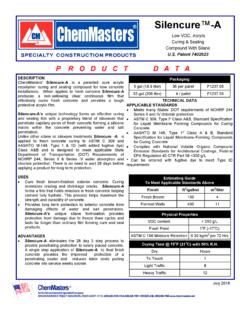

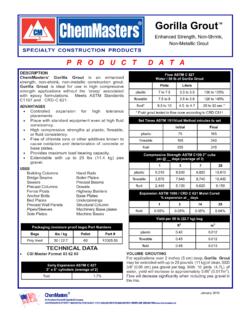

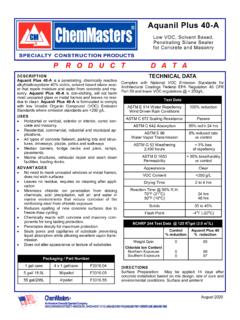
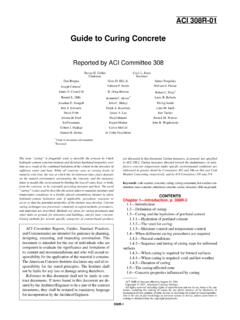
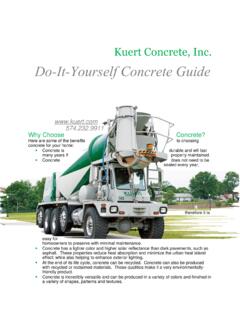
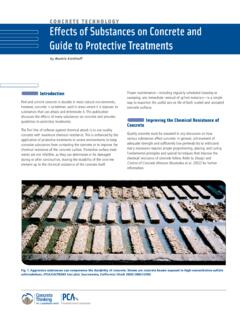
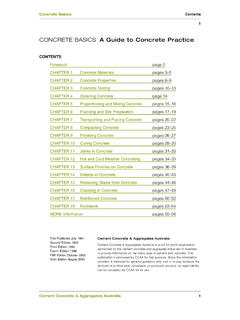
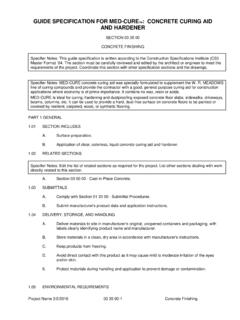
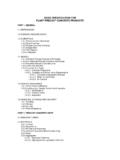

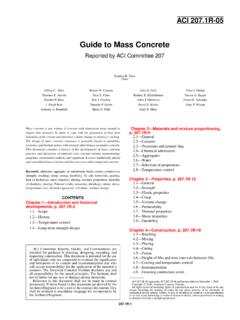
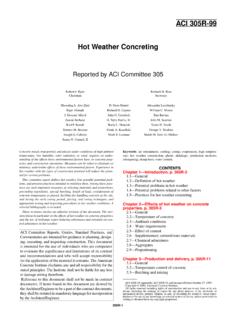
![6ITSVXIH F] %'- 'SQQMXXII - dl.mycivil.ir](/cache/preview/4/b/b/f/2/e/8/1/thumb-4bbf2e81b2b2df04c22714e49f0954ce.jpg)